Whey ricotta is a soft, creamy, and sweet-tasting cheese that is made from leftover sweet whey. It is delicious as a spread or baked into dishes like lasagna or tiramisu.
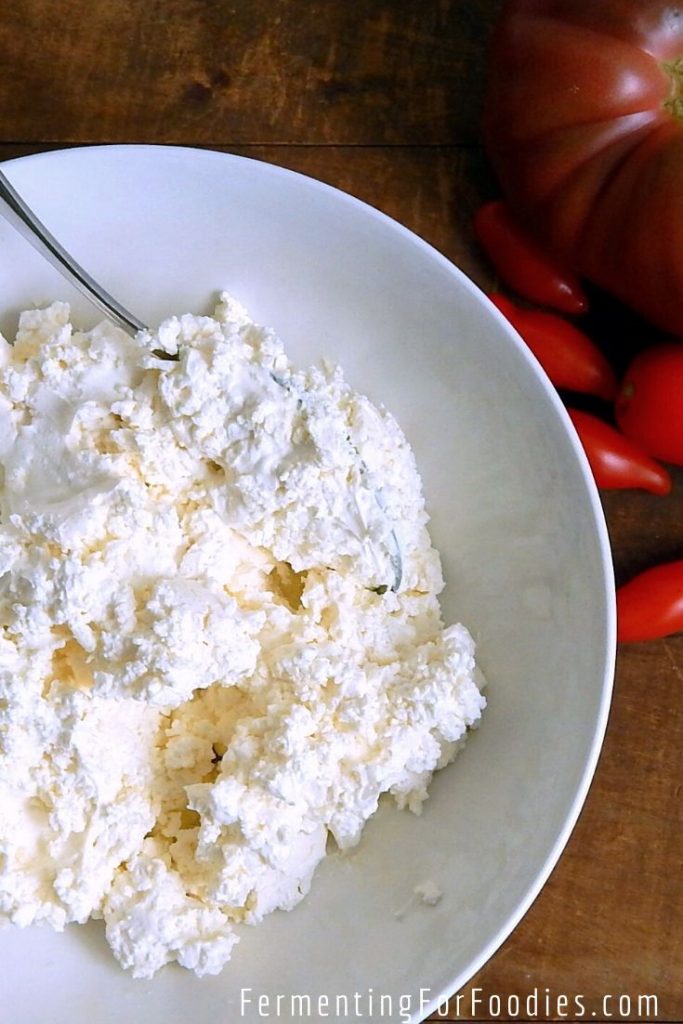
Types of Ricotta
There are a number of ways to make ricotta. While this recipe is for whey and milk-based ricotta, there are other recipes out there.
- Acid Ricotta: This is the most common ricotta recipe. Milk is curdled with citric acid or lemon juice, then strained. It makes bland ricotta that is perfect for blending into dishes.
- Kefir Ricotta: Using kefir to curdle milk results in a very tangy ricotta-like cheese.
- Halloumi Ricotta: If you make halloumi cheese, then you automatically get a little bit of ricotta forming when you poach your cheese. This is not a really efficient way to make ricotta because you only get 3 Tbsp of ricotta for one batch of halloumi.
- Whey ricotta: This is made from leftover sweet whey. (Whey from cheese that has only been cultured for a few hours. Which is typical of hard cheeses… not Greek yogurt). The whey is superheated until more curds are formed. Adding some milk to the recipe greatly increases the yield.
Superheated whey
Whey ricotta is far simpler than most hard cheeses, so this recipe doesn’t go into detail on each of the steps. However, if you want more information on cheesemaking, check out my general post on How to Make Homemade Cheese.
The only trick to making sweet whey ricotta is to heat the leftover whey up to 195F. At that point, the small curded proteins will rise to the top of the whey as seen in the photo below.
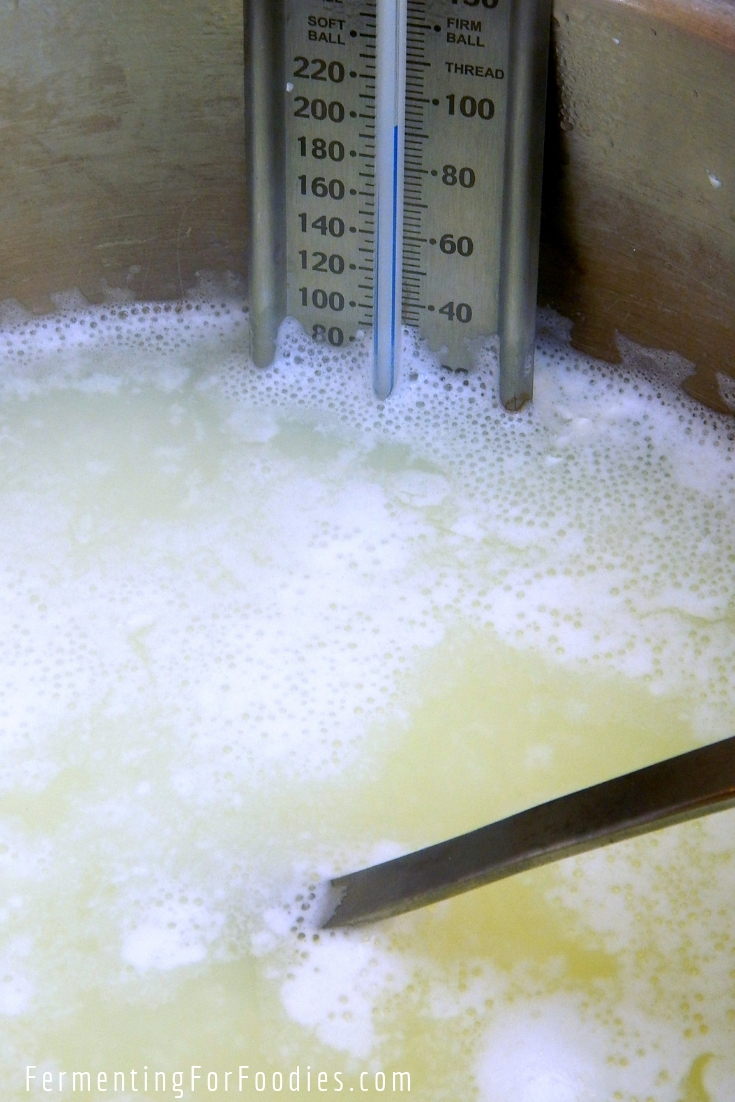
Traditional Sweet Whey Ricotta
Use leftover whey to make whey ricotta! Traditional whey ricotta is a sweet-tasting and flavorful cheese. It is a delicious way to use up whey!
- Cook Time: 20 minutes
- Total Time: 20 minutes
- Yield: 1.5 cups 1x
- Category: Cheese
- Cuisine: Italian
- Diet: Vegetarian
Ingredients
- 1 gallon of sweet whey (less than 3 hours old, see notes for details)
- 2 cups of whole milk
- 2 Tbsp cider vinegar (to curdle the additional milk)
- 1/4 tsp cheese salt (optional)
Instructions
- Combine the sweet whey and milk in a large pot. Gently heat on the stove to 91C (195F). If you don’t have a thermometer, you will know you have reached the right temperature when white curds rise to the surface. If you aren’t sure if you have sweet whey or acid whey, then please read the notes below. This recipe will not work with acid whey.
- Turn off the heat, add the vinegar and stir continuously for 2 minutes.
- Using a slotted spoon, carefully ladle the curds into a colander lined with butter muslin. Knot the muslin and hang it to drain for 2-4 hours.
- When you’re finished draining, mix in the salt.
- Store in the fridge for up to 1 week.
Notes
- It is really important to use sweet whey. This won’t work with acid whey (from acidic cheeses made with citric acid or vinegar). And it won’t work with whey from cheeses that have cultured for more than 3 hours (like Greek yogurt, kefir cheese, or cream cheese.) The reason why it is SO IMPORTANT to use fresh, sweet whey is that the bacteria in the whey continue to eat the lactose even after it has drained, slowly acidifying the whey. The proteins won’t curd in acidic whey.
- Typically, sweet whey is leftover from making hard cheeses. However, it can also be made with fresh cheese like feta.
- The yield from adding the 2 cups of milk is 1 1/2 cups of ricotta, which is really good.
- To make even sweeter ricotta (as a mascarpone substitute) add 1-2 Tbsp of cream after draining instead of the salt.
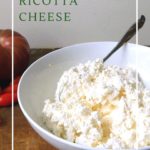
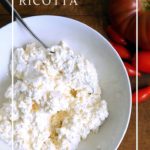
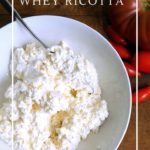

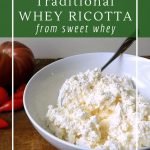
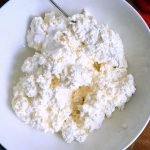
I made it twice, worked fine for me! In the past when making pannir, I found that getting it to the right temperature is super important. Do you have a good thermometer?
I’ve made it twice and it worked both times. Not a lot of ricotta, but worth it
Mine did not work as well. The whey was fresh and the temperature was on point. Could it because I used whey from yogurt? The yogurt was low fat though the milk I added for the ricotta was whole. Bummer. Back to the drawing board!
Yogurt whey is probably not fresh (unless you made the yogurt, then drained the whey right away.) It’s all about the level of acidity. Sweet whey is made from cheese that has been cultured for about an hour, then the whey is drained. So the culture has less than 3 hours to acidify the whey.
Sorry it didn’t work out! Try using the whey in soup or for baking instead.
Just finished making it and it worked out great! It’s draining now, and then I’ll add the salt and a bit of cream. The whey was from a bloomy rind goat cheese I just made. I added two cups of whole cow’s milk to the whey and followed you directions, and it looks perfect – can’t wait to eat it!!
Yum!
Hello! I thought I made ricotta yesterday. Using whole milk, I added vinegar, then drained the curds. Wallah! Then, I spoke to my mom (an Italian immigrant) who said that that’s not ricotta. Ricotta is from the whey! She called my creation “pre-cheese.” The whey from this process is in my fridge. Can I use it today? Using your recipe? Help! Thanks!
Unfortunately whey ricotta needs to be made from fresh sweet whey (made from a cultured cheese, like Parmesan, Romano or cheddar). To have this recipe work, the whey needs to be less than 3 hours old. Otherwise it becomes to acidic. The whey from a vinegar or lemon juice cheese is really too acidic.
However, vinegar ricotta is still very useful. I recommend using it for lasagna or other flavourful recipes. Whey ricotta has a richer flavour that really should be featured fresh.
Cheers, Emillie
It would have been helpful to see your note about the whey needing to be from a hard cheese in the actual recipe, as opposed to buried in a comment. Since I made chèvre yesterday/this morning, it looks like I wasted my time and milk trying to make this ricotta.
Hi, Ricotta can be made from whey with soft cultured cheese, just not Greek yogurt or yogurt cheese, as that will be very acidic. Sweet whey is only 3 hours old and tastes sweet. The whey from your chevre might work, depending on how long you cultured it. However, I will add a section to the recipe next week, specifically explaining what sweet whey is, rather than just referring to my other post on sweet whey. Cheers, Emillie
You made what is called queso fresco in El Salvador. I think some other places call it queso blanco. It’s yummy on beans, or with tortilla or on bread. Or crumbled over lots of different Hispanic foods. If you mush it into a plastic container, and then chill it, it will take the shape of the container, and you can cut slices.
So interesting! Thanks for sharing.
Nice I made this with Whey from a cheddar I did not add any milk so the yield was low but this is an easy and useful recipe. Thanks so much
I tried that once… without added milk you only get a few tablespoons of ricotta. Adding a bit of milk really makes it more worth it!
I tried making this right after making cream cheese and nothing… I tried years ago after making cheddar cheese and I got nothing then too. I used lemon juice it did nothing and then added apple cider vinegar and I thought it was going to curd but a few flakes (less then a tsp) and then nothing… I used a candy thermometer and followed the directions. So frustrated that this didn’t work for me.
Sorry this didn’t work for you… however, it’s because cream cheese makes acid whey. Typically cream cheese is cultured for at least 12 hours which is too acidic for sweet whey ricotta. I think part of the confusion around this recipe is that other sites say you can use all types of whey. (I noticed those sites don’t allow comments… so it allows the misconception to persist.)
However, it really has to be fresh sweet whey for this recipe to work (drained within 3 hours of first being cultured).
Cheers, Emillie
Made this with just shy of a gallon of whey from Asiago. Used 2% milk instead of whole and still got a good return! Will be adding this to my regular rotation after making my hard cheeses! Glad to pinch every penny out of my milk!
Great! Homemade Asiago sounds delicious. I’ve never tried it… hum… something to put on my list. Cheers, Emillie
I’m confused by the wording. Is the whey supposed to be be less than 3 hours old, or more than 3 hours old?
Less than 3 hours old. It needs to still have some lactose in it. The longer cultured whey waits, the more acidic it will become. This recipe only works with fresh whey, right after draining. Hopefully, I fixed the confusion in the recipe. 🙂